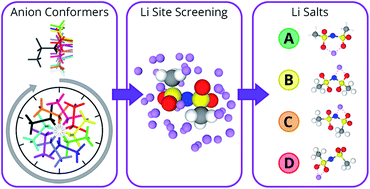Towards higher electrochemical stability of electrolytes: lithium salt design through in silico screening†
Abstract
Despite rapid advancements, Li-metal batteries still face a number of key challenges related to the stability of the electrolyte, of which a key component is the Li salt. Li salts based on the sulfonimide anions (TFSI−, FTFSI− and FSI−) and their corresponding ionic liquids have shown promise when used with the lithium-metal anode surface. However, given the multitude of anion and salt systems that could be used, it is impractical to design, synthesise and experimentally evaluate them all. Using a computational approach, systematic structural changes to the functional groups of the sulfonimide anion class (e.g. (R′/R′′SO2)2N, where the R′/R′′ groups are varied) have been investigated to determine which modifications lead to improvements in the calculated oxidative and reductive stability. Our results indicate that, regardless of significant structural changes resulting from different substituent R′/R′′ groups, there is minimal electron redistribution within the anion core in the presence of a Li counterion. However, different combinations of functional groups were found to shift the calculated Li binding energies and oxidation potentials. Specifically, highly electronegative functional groups weaken the Li-anion interaction and increase the oxidative stability of the anions, which are desirable properties for next-generation Li-ion and Li-metal batteries.



 Please wait while we load your content...
Please wait while we load your content...